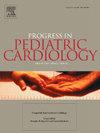Fontan assist devices; A systematic review of twenty years of experimental and in vivo trials
IF 0.6
Q4 PEDIATRICS
引用次数: 0
Abstract
Background
The Fontan completion represents the final phase of univentricular repair, which drains the inferior vena cava against gravity into a higher-pressure pulmonary arterial circulation. The passive and anti-gravity characteristics of this circulation make encountering a failing Fontan not uncommon. Twenty years ago, experiments exploring the potential of vascular pumps to bolster the passive Fontan have started, and trials are still ongoing.
Aim of review
Through this review, our aim is to summarize the outcomes of these trials.
Key scientific concepts and findings of review
A total of ten trials have been included, encompassing 23 different settings. Three distinct designs were identified, of which two are classified as pump designs: the connecting chamber and the intravascular pump designs. Only one trial investigated the potential use of a compression device. The most frequently encountered design in vivo was the intravascular pump, accounting for 67 % of the cases. There were no reports of significant hemolysis or thrombosis. However, an increasing flow rate exceeding 5 L/min was associated with negative outcomes in the connecting chamber design due to rising upstream pressure in the SVC. In contrast, intravascular pumps did not exhibit this limitation.
方坦辅助装置;二十年实验和体内试验的系统回顾
本文章由计算机程序翻译,如有差异,请以英文原文为准。
求助全文
约1分钟内获得全文
求助全文
来源期刊

PROGRESS IN PEDIATRIC CARDIOLOGY
PEDIATRICS-
CiteScore
0.90
自引率
11.10%
发文量
69
审稿时长
75 days
期刊介绍:
Progress in Pediatric Cardiology is an international journal of review presenting information and experienced opinion of importance in the understanding and management of cardiovascular diseases in children. Each issue is prepared by one or more Guest Editors and reviews a single subject, allowing for comprehensive presentations of complex, multifaceted or rapidly changing topics of clinical and investigative interest.
 求助内容:
求助内容: 应助结果提醒方式:
应助结果提醒方式:


